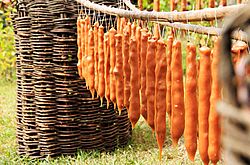Churchkhela facts for kids

Kakhetian churchela
|
|
| Alternative names | Churchela |
|---|---|
| Type | Confectionery |
| Place of origin | Georgia |
| Main ingredients | Grape must, nuts, flour |
| Top - 0-9 A B C D E F G H I J K L M N O P Q R S T U V W X Y Z |
Churchkhela (Georgian: ჩურჩხელა) is a special candle-shaped candy. It comes from the country of Georgia. This tasty treat is a big part of Georgian cuisine.
The main things used to make Churchkhela are grape juice, nuts, and flour. People usually thread almonds, walnuts, or hazelnuts onto a string. Then, they dip these strings into thick grape juice. Sometimes, they use mulberry juice or other fruit juices. After dipping, the strings are hung to dry. They end up looking a bit like a sausage.
In eastern Georgia, they start with a thick juice called tatara. This juice is made from local grapes and wheat flour. In western Georgia, they use corn flour. This thick grape juice is called pelamushi. In a region called Abkhazia, it's known as "Adzhindzhukhua." Many people think it's a great souvenir to give as a gift.
Long ago, Georgian warriors would carry Churchkhelas with them. This was because the candy gives a lot of energy. It helped them stay strong during their journeys.
The traditional way of making Churchkhela in the Kakheti region is very important. It was added to Georgia's list of special cultural heritage in 2015.
Where is Churchkhela popular?
Churchkhela is loved in many places beyond Georgia. You can find it in countries like Armenia, Azerbaijan, and Turkey. It's also popular in Iraq, Syria, Iran, Cyprus, and Greece. Even in Russia and Ukraine, people enjoy this candy.
In Persian, it's called باسلوق شیره انگور. In Aleppo, Syria, it's known as zob alkadi. In some places, it's called "sujuk," which is also the name for a dry sausage. To tell them apart, people might call it "sweet sujukh" or "walnut sujuk." In Cypriot Greek, it's called shoushoukos.
Greece also has similar sweets made from grape juice. These include thick grape molasses and grape juice puddings. Another type of Churchkhela is made in Pakistan. It's called Kelawo or Hunza Candy.
The Cypriot version is made by dipping strings of almonds into a jelly called palouzes.
How is Churchkhela made?
Churchkhela is often made at home in Georgia. People usually make it in the autumn. This is when grapes and nuts are ready to be picked. It starts with a string of nuts, usually walnut halves. These nuts are dipped into a thick grape juice. This juice is made by thickening grape juice with flour.
No extra sugar is added to real Churchkhela. Sometimes, people use hazelnuts or almonds instead of walnuts. This depends on the region in west Georgia.
First, the grape juice is heated slowly in a large pot. A special white earth is sometimes added. This helps to clean the juice by bringing impurities to the top. These impurities are then removed. After cleaning, the liquid cools down. Next, flour is added while stirring and heating the mix. When it gets thick enough, it's taken off the heat. This thick mixture is called Badagi.
Before dipping, the nuts are shelled. They are then soaked in water to make them soft. Once soft, they are threaded onto long strings. The strings of nuts are dipped into the Badagi mixture. They are covered completely. This dipping is done several times, usually three times. This makes the Churchkhela the right thickness.
After dipping, the Churchkhela strings are hung to dry. They usually dry for about 5 to 6 days. Then, they are ready to eat or store for later. Some people like to eat them fresh.
When is Churchkhela eaten?
Churchkhela is a popular snack to eat between meals. It is also served as a dessert during special times. These include New Year and Christmas celebrations.
Traditionally, during times of war, women would send Churchkhela to their men. It was easy to carry and stayed fresh for a long time. Its rich texture also helped keep them full.
Images for kids
See also
- In Spanish: Churchjela para niños








